
Riau is a province of Indonesia. It is located on the central eastern coast of the island of Sumatra, and extends from the eastern slopes of the Barisan Mountains to the Malacca Strait, including several large islands situated within the Strait. The province shares land borders with North Sumatra to the northwest, West Sumatra to the west, and Jambi to the south, and a maritime border with the Riau Islands and the country of Malaysia to the east. It is the second-largest province in the island of Sumatra after South Sumatra, and is slightly larger than the nation of Jordan. According to the 2020 census, Riau had a population of 6,394,087 across a land area of 89,935.90 km²; the official estimate of population as of mid-2023 was 6,642,874. The province comprises ten regencies and two cities, with Pekanbaru serving as the capital and largest city.

Medan is the capital and largest city of the Indonesian province of North Sumatra. The nearby Strait of Malacca, Port of Belawan, and Kualanamu International Airport make Medan a regional hub and multicultural metropolis, acting as a financial centre for Sumatra and a gateway to the western part of Indonesia. About 60% of the economy in North Sumatra is backed by trading, agriculture, and processing industries, including exports from its 4 million acres of palm oil plantations. The National Development Planning Agency listed Medan as one of the four main central cities in Indonesia, alongside Jakarta, Surabaya, and Makassar. In terms of population, it is the most populous city in Indonesia outside of the island of Java. Its population as of 2023 is approximately equal to the country of Moldova.
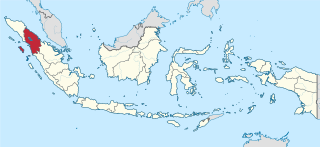
North Sumatra, also called North Sumatra Province, is a province of Indonesia located in the northern part of the island of Sumatra, just south of Aceh. Its capital and largest city is Medan on the east coast of the island. It is bordered by Aceh on the northwest and Riau and West Sumatra on the southeast, by coastlines located on the Indian Ocean and the Strait of Malacca, and by a maritime border with Malaysia to the east.

Malay houses refer to the vernacular dwellings of the Malays, an ethno-linguistic group inhabiting Sumatra, coastal Borneo and the Malay Peninsula.
Istana is an Indonesian and Malay word meaning "palace". It may refer to:
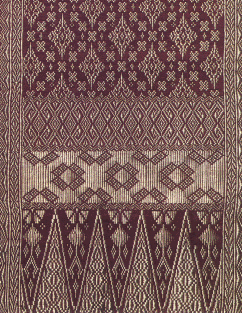
Songket or sungkit is a tenun fabric that belongs to the brocade family of textiles of Brunei, Indonesia, Malaysia, and Singapore. It is hand-woven in silk or cotton, and intricately patterned with gold or silver threads. The metallic threads stand out against the background cloth to create a shimmering effect. In the weaving process the metallic threads are inserted in between the silk or cotton weft (latitudinal) threads in a technique called supplementary weft weaving technique.

Sultan of Selangor is the title of the constitutional ruler of Selangor, Malaysia who is the head of state and head of the Islamic religion in Selangor. The current monarch, Sultan Sharafuddin Idris Shah ascended the throne on the death of his father, on 22 November 2001.

The Sultanate of Deli was a 1,820 km² Malay state in east Sumatra founded in 1630. A tributary kingdom from 1630 it was controlled by various Sultanates until 1814, when it became an independent sultanate and broke away from the Sultanate of Siak.

The Pontianak Kadriyah Sultanate was an Islamic Malay state that existed on the western coast of the island of Borneo from the late 18th century until its disestablishment in 1950. It was founded in 1771 by Sultan Syarif Abdurrahman Ibni Alhabib Husein bin Ahmad Alkadrie, allegedly a descendant of Sayidina Husain, in the area of the mouth of the triple junction of the small Kapuas River and the porcupine river which included a small area area ceded by the Sultan of Banten to the Dutch VOC. He had two political marriages in Kalimantan, the first to the princess of the Mempawah Kingdom, Utin Chandramidi, and the second in 1768 to Ratu Syahranum of the Banjar Sultanate, earning him the title Pangeran Nur Alam.

The Sultanate of Langkat was a Malay Muslim state located in modern Langkat Regency, North Sumatra. It predates Islam in the region, but no historical records before the 17th century survive. It prospered with the opening of rubber plantations and the discovery of oil in Pangkalan Brandan.

The Indonesian island of Sumatra is the sixth largest island in the world. The rich ethnic diversity and historical heritage in Sumatra is reflected in the range of architectural styles in the island. The vernacular style is the native Sumatran ethnic groups architecture of dwellings, while the Hindu-Buddhist architecture reflected through the cultural historical heritage of candis built in Sumatra. The third wave is Islamic architecture adopted in mosques and palace in Sumatra, especially in Aceh, North Sumatra, and Malay cultural sphere in the island.

Cultural properties of Indonesia are those items defined by Indonesian law as of "important value for history, science, and culture", and include both man-made artefacts and natural objects. The cultural properties number more than 8,000 and include ancient Hindu and Buddhist temples, mosques, historic colonial buildings, forts, art galleries, national parks and beaches. A number of the sites are World Heritage Sites.
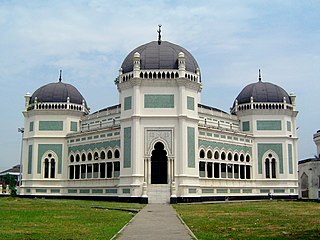
Grand Mosque of Medan or Masjid Raya Al-Mashun is a mosque located in Medan, Indonesia. The mosque was built in the year 1906 and completed in 1909. In beginning of its establishment, the mosque was a part of the Maimun palace complex. Its architectural style combines Middle Eastern, Indian, and Spanish elements. The mosque has an octagonal shape and has wings to the south, east, north, and west.

Riau-Lingga Sultanate, also known as the Lingga-Riau Sultanate, Riau Sultanate or Lingga Sultanate was a Malay sultanate that existed from 1824 to 1911, before being dissolved following Dutch intervention.

Aru was a major Sumatran kingdom from the 13th to the 16th century. It was located on the eastern coast of North Sumatra, Indonesia. In its heyday the kingdom was a formidable maritime power, and was able to control the northern part of the Malacca strait.

Siak Sri Indrapura Palace or Siak Palace is an istana of the Sultanate of Siak Sri Indrapura that is located at Siak Regency, Riau, on the island of Sumatra, Indonesia. The palace is now transformed into a museum.
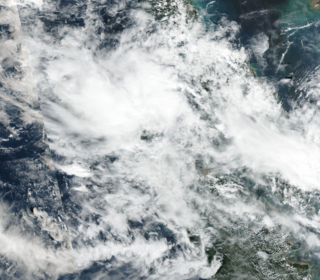
From 3 to 8 December 2020, several floods and flash floods impacted various areas within Indonesia and Malaysia, causing mass property damage, injuring and killing many, and prompting the evacuation of those in affected houses. They were caused by a convergence zone formed by Cyclone Burevi in Sri Lanka and a low-pressure area in the Philippines. Wider coverage was done on the floods in the province of North Sumatra, which killed eight, injured 5,000, and damaged over 2,000 properties. The ones in neighboring province Aceh affected over 8,000 people, and those in Malaysia affected over 2,000 people across four states. Meanwhile, floods also impacted the Indonesian island of Java, though with less severity.
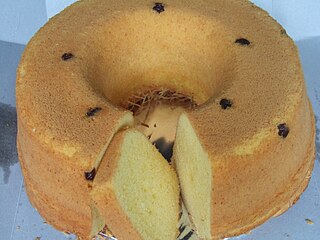
Kue bolu or simply Bolu is an Indonesian term that describes a wide variety of sponge cakes, tarts and cupcakes.

























